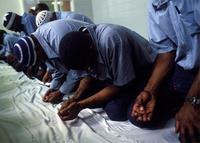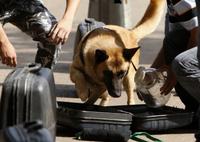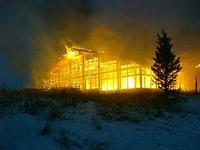-
Tiny particles could help verify goods

Chemical engineers hope smartphone-readable microparticles could crack down on counterfeiting. Some 2 to 5 percent of all international trade involves counterfeit goods, according to a 2013 United Nations report. These illicit products — which include electronics, automotive and aircraft parts, pharmaceuticals, and food — can pose safety risks and cost governments and private companies hundreds of billions of dollars annually. Researchers have invented a new type of tiny, smartphone-readable particle that they believe could be deployed to help authenticate currency, electronic parts, and luxury goods, among other products. The particles, which are invisible to the naked eye, contain colored stripes of nanocrystals that glow brightly when lit up with near-infrared light.
-
-
U.K. prisons serve as recruitment centers for jihadi causes

A recent report details the growing population of Muslims in British jails, many of whom are declared Islamic extremists. Top-security prison Whitemoor, home to many extremists serving life sentences for plotting acts of terror in the United Kingdom, is considered a recruitment center for al-Qaeda, according to prison inspectors. Roughly 42 percent of prisoners at Whitemoor are Muslims, a stark contrast to the overall U.K. population in which only 5 percent practice Islam.In all, there are 11,729 Muslims in British jails, about one in seven of all inmates.
-
-
Gangbangin' in Syria: Two L.A. gang members in Syria to defend Assad regime
About a hundred Americans have gone to Syria to take part in the war, all of them — with the apparent exception of two L.A. gang members named “Creeper” and “Wino” — to fight on the side of the Sunni rebels against the Alawite Assad regime. In a video recently posted on YouTube, the two are shown brandishing AK-47s and firing at an unseen enemy. Their tattoos identify one of them as a member of Sureños-13, which is affiliated with the Mexican mafia, and the other as a member of Westside Armenian Power gang. They tell the camera they are “in Syria, gangbangin’.”
-
-
How dogs detect explosives: New training recommendations

Researchers have helped determine the science behind how canines locate explosives such as Composition C-4 (a plastic explosive used by the U.S. military). The study found the dogs react best to the actual explosive, calling into question the use of products designed to mimic the odor of C-4 for training purposes.
-
-
Secure Communities triggers deportation of undocumented immigrants with no criminal records
The U.S. Immigration and Customs Enforcement’s (ICE) Secure Communitiesprogram sends fingerprint data from local law enforcement and the Federal Bureau of Investigationto immigration officers to identify and deport illegal immigrants who commit major crimes. The program has expanded from fourteen jurisdictions in 2008 to more than 3,000 today. Immigration advocates say that the program’s emphasis on identifying and deporting undocumented immigrants who have committed crimes in the United States notwithstanding, it has also triggered the deportation of 5,964 undocumented immigrants with no criminal records.
-
-
Wal-Mart effect: Decline in crime rates slower where Wal-Mart builds

Communities across the United States experienced an unprecedented decline in crime in the 1990s. For counties where Wal-Mart built stores, however, the decline was not nearly as dramatic. A new study examines crime rate in 3,109 U.S. counties in the 1990s, a time of dynamic growth and expansion for Wal-Mart and falling crime rates nationally. During that decade, Wal-Mart expanded in 767 of those counties. The researchers show that Wal-Mart tended to expand in counties with higher than average crime rates, and with numerous crime-related predicators, such as poverty, unemployment, immigration, population structure, and residential turnover. The researchers speculate that much of this relationship occurred because Wal-Mart finds better success building in communities that are less likely to protest the company’s arrival.
-
-
FBI monitors Americans back from fighting in rebel ranks in Syria

Western intelligence services estimate that 2,100 Europeans and seventy Americans have fought in Syria. U.S. intelligence officials report that some of these Americans have returned to the United States and are under FBI surveillance. There is a concern that individuals who have been trained by al-Qaeda affiliates will ultimately use their battlefield experience to launch attacks in the United States.
-
-
Growing body of evidence connects lead’s deleterious effects to criminal behavior
Violent crimes had reached an all-time high in the United States in the early 1990s, but by the end of the decade, the homicide rate had plummeted by more than 40 percent. Many theories were offered to explain this dramatic decline, but a new explanation is gaining credence: the banning of lead from gasoline and paint in the early 1970s. Babies born post-ban were exposed to far less lead – with its proven contribution to lowering IQ and causing attention problems and antisocial tendencies — and twenty years on, these babies became young adults who committed fewer crimes than their predecessors.
-
-
National Guard units help states ward off cyberattacks
Governors across the United States are mobilizing their states’ National Guard units to combat threats from cyberattacks. The state of Washington was the first state to assign the state’s National Guard cybersecurity responsibilities. The state recognized the potential of its National Guard as a cyberforce when it realized that many of its soldiers, who are full-time employees and part-time soldiers, worked for tech employers such as Google, Boeing, Cisco, Verizon, and Microsoft.
-
-
Eco-terrorist sentenced to five years and ordered to read Malcolm Gladwell’s book

Last Monday, Chief U.S. District Judge Ann Aiken imposed a 5-year sentence on radical environmental activist Rebecca Rubin for her involvement in several acts of arson, including the burning of Vail Colorado’s Twin Elks Lodge which caused millions of dollars in damage. Rubin spent almost eight years living underground, giving herself up to the FBI last October. She pleaded guilty to arson, attempted arson, and conspiracy to commit arson in connection with a radical environmental group calling itself The Family. Judge Aiken also ordered Rubin to read Malcolm Gladwell’s 2013 book David and Goliath, explaining that Rubin might learn a thing or two about non-violent environmental advocacy while serving her sentence.
-
-
U.S. will seek death penalty for Dzhokhar Tsarnaev
The U.S. Justice Department announced that the United States will seek the death penalty against Dzhokhar Tsarnaev, the 20-year-old accused of detonating two bombs the Boston Marathon last Aril, killing three people and injuring more than 200 others. The younger Tsarnaev faces thirty counts in the bombing, including use of a weapon of mass destruction resulting in death and the bombing of a public place. Since 1964, the federal government has only executed three people, including Timothy McVeigh who was convicted in the 1995 Oklahoma City bombing.
-
-
A first: Constitutionality of NSA warrantless surveillance challenged by terrorism suspect
Jamshid Muhtorov, a refugee from Uzbekistan now facing terrorism charges in Colorado, is the first criminal defendant who, as part of his lawyers’ defense strategy, is challenging the constitutionality of the NSA’s warrantless surveillance program. Muhtorov filed a motion Wednesday in federal court in Denver to suppress any evidence obtained through the agency’s surveillance program on grounds that it was unlawful. In July 2013 the Justice Department reversed an earlier policy, and now informs defendants whether the case against them, in whole or in part, is based on information obtained through warrantless surveillance. To date, six months after the review process at Justice was launched, Muhtorov and Mohamed Mohamud, a Portland, Oregon teenager who had been convicted after an FBI sting operation of attempting to detonate a bomb at a Christmas tree lighting ceremony, are the only defendants to receive such a disclosure.
-
-
A first: Judge in terrorism case rules defense may examine government secret FISA application
U.S. District Judge Sharon Johnson Coleman ruled yesterday (Wednesday) that the U.S. government cannot keep secret its request to conduct clandestine surveillance of an accused would-be terrorist. The ruling gives defense attorneys an unprecedented access to a request made to the Foreign Intelligence Surveillance Act (FISA) court for permission to spy on an American citizen. Judge Coleman said her ruling is the first time a defendant’s lawyers will be given access to an application prosecutors submitted to the FISA court. Security experts warned that opening FISA applications to review in a criminal case may set a dangerous precedent.
-
-
Last meals on death row may indicate guilt or innocence
Can last meals reveal more about individuals on death row than their taste preference? A new study examined whether an individual who has accepted guilt — by apologizing or confessing — is more likely to indulge in a last meal. The study found that those who denied guilt were 2.7 times more likely to decline a last meal than those who admitted guilt. Furthermore, those who were admittedly guilty requested 34 percent more calories of food and were more likely to request brand name, comfort-food items.
-
-
Restrictive concealed weapons laws correlated with an increase in gun-related murders

It may make sense to assume that states in which there are tight laws on weapons would make that state a safer place and one with less gun crime, but recent research argues that the very opposite is true. Research shows that in states with more restrictive concealed carry weapons (CCW) laws there is actually an increase in gun related crime. The author notes that his study looks solely at gun crime, rather than violent crime, which is the case in similar research.
-
More headlines
The long view
Why Was Pacific Northwest Home to So Many Serial Killers?
Ted Bundy, Gary Ridgway, George Russell, Israel Keyes, and Robert Lee Yates were serial killers who grew up in the Pacific Northwest in the shadow of smelters which spewed plumes of lead, arsenic, and cadmium into the air. As a young man, Charles Manson spent ten years at a nearby prison, where lead has seeped into the soil. The idea of a correlation between early exposure to lead and higher crime rates is not new. Fraser doesn’t explicitly support the lead-crime hypothesis, but in a nimble, haunting narrative, she argues that the connections between an unfettered pollution and violent crime warrant scrutiny.
